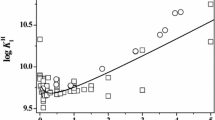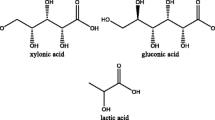Abstract
The acidity constant values (Ka or pKa) and polyionic species distribution are valuable tools to identify the extent of ionization and complexing properties of polyionic species. They are of great importance to predict the charged state of analyte and choose the appropriate condition in the design of functional materials for their intended purposes. Polyphosphates, being one of the anionic types of polyelectrolytes, have attracted interest for utilization in a quite wide range of applications in the boundaries of nanomaterial, bio-analytical chemistry, and physical sciences. In this study, it is aimed to estimate the intrinsic pK oa of polyphosphoric acid (PPH) with high molar mass and the charge of its polyanionic conjugate base (PP−), \((Z_{{\text{PP}}^{-}})\), according to activity coefficient estimation by Davies using potentiometric titration along with the theoretical consideration of Gran’s approach. Besides, a series of PPH titration was simulated via CurTiPot and the data were further treated in MATLAB to visualize the 3-D pH surfaces of PPH/PP− pairs. As a result, the outcomes of experimental work and simulations were consistent very well, and pK oa of PPH and \(Z_{{\text{PP}}^{-}}\) were found as 2.22 ± 0.01 and − 1.105 ± 0.003, respectively, at a 95% confidence interval.




Similar content being viewed by others
Data Availability
All data generated or analyzed during this study are included in this published article [and its supplementary information files].
References
Richardson, J.J., Björnmalm, M., Caruso, F.: Technology-driven layer-by-layer assembly of nanofilms. Science 348, aaa2491 (2015). https://doi.org/10.1126/science.aaa2491
der Meeren, L.V., Li, J., Parakhonskiy, B.V., Krysko, D.V., Skirtach, A.G.: Classification of analytics, sensorics, and bioanalytics with polyelectrolyte multilayer capsules. Anal. Bioanal. Chem. 412, 5015–5029 (2020). https://doi.org/10.1007/s00216-020-02428-8
Decher, G.: Fuzzy nanoassemblies: toward layered polymeric multicomposites. Science 277, 1232–1237 (1997). https://doi.org/10.1126/science.277.5330.1232
Schaaf, P., Schlenoff, J.B.: Saloplastics: processing compact polyelectrolyte complexes. Adv. Mater. 27, 2420–2432 (2015). https://doi.org/10.1002/adma.201500176
Roca, S., Dhellemmes, L., Leclercq, L., Cottet, H.: Polyelectrolyte multilayers in capillary electrophoresis. ChemPlusChem 87, e202200028 (2022). https://doi.org/10.1002/cplu.202200028
Dautzenberg, H., Jaeger, W., Kötz, J., Philipp, B., Seidel, C., Stscherbina, D.: Polyelectrolytes: Formation, Characterization and Application. Carl Hanser Verlag, Munich (1994)
Asuero, A.G., Michalowski, T.: Comprehensive formulation of titration curves for complex acid-base systems and its analytical implications. Crit. Rev. Anal. Chem. 41, 151–187 (2011). https://doi.org/10.1080/10408347.2011.559440
Wallace, M., Adams, D.J., Iggo, J.A.: Titrations without the additions: the efficient determination of pKa values using NMR imaging techniques. Anal. Chem. 90, 4160–4166 (2018). https://doi.org/10.1021/acs.analchem.8b00181
Wiczling, P., Waszczuk-Jankowska, M., Markuszewski, M.J., Kaliszan, R.: The application of gradient reversed-phase high-performance liquid chromatography to the pKa and log Kw determination of polyprotic analytes. J. Chromatogr. A. 1214, 109–114 (2008). https://doi.org/10.1016/j.chroma.2008.10.085
Nowak, P.M., Leszczenko, P., Zarusińska, J., Kościelniak, P.: Acidity constant of pH indicators in the supramolecular systems studied by two CE-based methods compared using the RGB additive color model. Anal. Bioanal. Chem. 412, 577–588 (2020). https://doi.org/10.1007/s00216-019-02289-w
Nowak, P., Woźniakiewicz, M., Kościelniak, P.: Application of capillary electrophoresis in determination of acid dissociation constant values. J. Chromatogr. A. 1377, 1–12 (2015). https://doi.org/10.1016/j.chroma.2014.12.032
Šolínová, V., Kašička, V.: Determination of acidity constants and ionic mobilities of polyprotic peptide hormones by CZE. Electrophoresis 34, 2655–2665 (2013). https://doi.org/10.1002/elps.201300119
Liu, B., Tian, Y., Yu, Q., Li, Q., Mu, W., Tan, Z., Wu, F., Wang, D., Li, X.: Determination of protonation constants of o-Phospho-l-serine in aqueous solution: Potentiometry, microcalorimetry, NMR spectroscopy and quantum chemical calculations. J. Solution Chem. 46, 2281–2292 (2017). https://doi.org/10.1007/s10953-017-0696-6
Meloun, M., Pilařová, L., Pfeiferová, A., Pekárek, T.: Method of UV-metric and pH-metric determination of dissociation constants of ionizable drugs: Valsartan. J. Solution Chem. 48, 1266–1286 (2019). https://doi.org/10.1007/s10953-019-00913-y
Koort, E., Gans, P., Herodes, K., Pihl, V., Leito, I.: Acidity constants in different media (I = 0 and I = 0.1 M KCl) from the uncertainty perspective. Anal. Bioanal. Chem. 385, 1124–1139 (2006). https://doi.org/10.1007/s00216-006-0519-x
Benet, L.Z., Goyan, J.E.: Potentiometric determination of dissociation constants. J. Pharm. Sci. 56, 665–680 (1967)
Reijenga, J., van Hoof, A., van Loon, A., Teunissen, B.: Development of methods for the determination of pKa values. Anal. Chem. Insights. 8, 53–71 (2013). https://doi.org/10.4137/ACI.S12304
Jano, I., Hardcastle, J., Jano, L.A., Bates, K.R., McCreary, H.E.: General equation for determining the dissociation constants of polyprotic acids and bases from additive properties Part IV. Application to potentiometric titration. Anal. Chim. Acta. 428, 309–321 (2001). https://doi.org/10.1016/S0003-2670(00)01242-3
Maslarska, V., Tencheva, J., Budevsky, O.: New approach in the treatment of data from an acid-base potentiometric titration. Anal. Bioanal. Chem. 375, 217–222 (2003). https://doi.org/10.1007/s00216-002-1671-6
Michałowski, T., Toporek, M., Rymanowski, M.: Overview on the Gran and other linearisation methods applied in titrimetric analyses. Talanta 65, 1241–1253 (2005). https://doi.org/10.1016/j.talanta.2004.08.053
Gran, G.: Determination of the equivalent point in potentiometric titrations. Acta Chem. Scand. 4, 559–577 (1950). https://doi.org/10.3891/acta.chem.scand.04-0559
Cini, N., Ball, V.: Polyphosphates as inorganic polyelectrolytes interacting with oppositely charged ions, polymers and deposited on surfaces: Fundamentals and applications. Adv. Colloid Interface Sci. 209, 84–97 (2014). https://doi.org/10.1016/j.cis.2014.01.011
Davies, C.W.: The extent of dissociation of salts in water. Part VIII. An equation for the mean ionic activity coefficient of an electrolyte in water, and a revision of the dissociation constants of some sulphates. J. Chem. Society Part II (1938). https://doi.org/10.1039/JR9380002093
Gutz, I.G.R.: CurTiPot – pH and Acid–Base Titration Curves: Analysis and Simulation Software, Version 4.3.1. http://www.iq.usp.br/gutz/Curtipot_.html, Retrieved 2021,11th January (2021)
MATLAB, version 9.5.0.944444 (R2018b). The MathWorks Inc., Natick, Massachusetts, United States (2018)
Klingenberg, J.J., Kim, H.Z.: Preparation and analysis by ion exchange techniques of sodium salts of mandelic acid derivatives. Ohio J. Sci. 66, 587–590 (1966)
Griffith, E.J.: The chemical and physical properties of condensed phosphates. Pure Appl. Chem. 44, 173–200 (1975). https://doi.org/10.1351/pac197544020173
Thilo, E.: Condensed phosphates and arsenates. Adv. Inorg. Chem. Radiochem. 4, 1–75 (1962). https://doi.org/10.1016/S0065-2792(08)60265-4
De Jager, H.J., Heyns, A.M.: Kinetics of acid-catalyzed hydrolysis of a polyphosphate in water. J. Phys. Chem. A. 102, 2838–2841 (1998). https://doi.org/10.1021/jp9730252
Zinder, B., Hertz, J., Oswald, H.R.: Kinetic studies on the hydrolysis of sodium tripolyphosphate in sterile solution. Water Res. 18, 509–512 (1984). https://doi.org/10.1016/0043-1354(84)90196-9
Dickman, S.R., Bray, R.H.: Colorimetric determination of phosphate. Ind. Eng. Chem. - Anal. Ed. 12, 665–668 (1940). https://doi.org/10.1021/ac50151a013
Momeni, A., Filiaggi, M.J.: Comprehensive study of the chelation and coacervation of alkaline earth metals in the presence of sodium polyphosphate solution. Langmuir 30, 5256–5266 (2014). https://doi.org/10.1021/la500474j
Katchalsky, A., Gillis, J.: Theory of the potentiometric titration of polymeric acids. Rec. Trav. Chim. Pays-Bas. 68, 879–897 (1949)
Smith, G.C., Hossain, M.M., MacCarthy, P.: 3-D surface visualization of pH titration “topos”: equivalence point cliffs, dilution ramps, and buffer plateaus. J. Chem. Ed. 91, 225–231 (2014). https://doi.org/10.1021/ed400297t
Lorenz, B., Schröder, H.C.: Methods for Investigation of Inorganic Polyphosphates and Polyphosphate-Metabolizing Enzymes. In: Schroder, H.C., Müller, W.E.G. (eds.) Inorganic Polyphosphates: Biochemistry, Biology, Biotechnology, Progress In Molecular And Subcellular Biology Book Series, 23, pp. 217–239. Springer-Verlag, Heidelberg, Germany (1999)
Wazer, J.R.V., Holst, K.A.: Structure and properties of the condensed phosphates. I. Some general considerations about phosphoric acids. J. Am. Chem. Soc. 72, 639–644 (1950). https://doi.org/10.1097/00007611-192203000-00016
Wall, F.T., Doremus, R.H.: Electrolytic transference properties of polyphosphates. J. Am. Chem. Soc. 76, 868–870 (1954). https://doi.org/10.1021/ja01632a069
Callis, C.F., Wazer, J.R.V., Arvan, P.G.: The inorganic phosphates as polyelectrolytes. Chem. Rev. 54, 777–796 (1954)
Mandel, M.: The potentiometric titration of weak polyacids. Eur. Polym. J. 6, 807–822 (1970)
Porasso, R.D., Benegas, J.C., van den Hoop, M.A.G.T., Paoletti, S.: Analysis of potentiometric titrations of heterogeneous natural polyelectrolytes in terms of counterion condensation theory: Application to humic acid. Biophys. Chem. 86, 59–69 (2000). https://doi.org/10.1016/S0301-4622(00)00159-9
Nová, L., Uhlík, F., Košovan, P.: Local pH and effective pKA of weak polyelectrolytes-insights from computer simulations. Phys. Chem. Chem. Phys. 19, 14376–14387 (2017). https://doi.org/10.1039/c7cp00265c
Ghasemi, M., Larson, R.G.: Role of electrostatic interactions in charge regulation of weakly dissociating polyacids. Prog. Polym. Sci. 112(10132), 1–11 (2021). https://doi.org/10.1016/j.progpolymsci.2020.101322
Wazer, J.R.V., Callis, C.F.: Metal complexing by phosphates. Chem. Rev. 58, 1011–1046 (1958)
Robinson, T.E., Arkinstall, L.A., Cox, S.C., Grover, L.M.: Determining the structure of hexametaphosphate by titration and 31P-NMR spectroscopy. Comments Inorg. Chem. 42, 47–59 (2022). https://doi.org/10.1080/02603594.2021.1973444
Vleugels, L.F.W., Ricois, S., Voets, I.K., Tuinier, R.: Determination of the ‘apparent pKa’ of selected food hydrocolloids using ortho-toluidine blue. Food Hydrocoll. 81, 273–283 (2018)
Kodama, H., Miyajima, T., Mori, M., Takahashi, M., Nishimura, H., Ishiguro, S.: A unified analytical treatment of the acid-dissociation equilibria of weakly acidic linear polyelectrolytes and the conjugate acids of weakly basic linear polyelectrolytes. Colloid Polym. Sci. 275, 938–945 (1997). https://doi.org/10.1007/s003960050169
Ibrahim, A., Koval, D., Kašička, V., Faye, C., Cottet, H.: Effective charge determination of dendrigraft poly- l -lysine by capillary isotachophoresis. Macromolecules 46, 533–540 (2013). https://doi.org/10.1021/ma302125f
Manning, G.S.: Counterion binding in polyelectrolyte theory. Acc. Chem. Res. 12, 443–449 (1979). https://doi.org/10.1021/ar50144a004
Stuart, M.C., de Vries, R., Lyklema, H.: Chapter 2—Polyelectrolytes. In: Lyklema, J. (ed.) Fundamentals of Interface and Colloid Science: Soft Colloids, vol. 5, p. 2.1-2.84. Academic Press, Amsterdam (2005). https://doi.org/10.1016/S1874-5679(05)80006-6
Kitano, T., Kawaguchi, S., Ito, K., Minakata, A.: Dissociation behavior of poly(fumaric acid) and poly (maleic acid). 1. Potentiometric titration and intrinsic viscosity. Macromolecules 20, 1598–1606 (1987). https://doi.org/10.1021/ma00173a028
Tømmeraas, K., Wahlund, P.O.: Poly-acid properties of biosynthetic hyaluronan studied by titration. Carbohydr. Polym. 77, 194–200 (2009). https://doi.org/10.1016/j.carbpol.2008.12.021
Fechner, M., Koetz, J.: Potentiometric behavior of polyampholytes based on N,N–diallyl–N,N–dimethylammonium chloride and maleamic acid derivatives. Macromol. Chem. Phys. 212, 2691–2699 (2011). https://doi.org/10.1002/macp.201100532
Rueda, C., Arias, C., Galera, P., López-Cabarcos, E., Yagüe, A.: Mucopolysaccharides in aqueous solutions: effect of ionic strength on titration curves. Farmaco 56, 527–532 (2001). https://doi.org/10.1016/S0014-827X(01)01106-5
Debye, P., Hückel, E.: Zur Theorie der elektrolyte. Phys. Zeitschrift. 24, 185–206 (1923)
Maechling, C., Ball, V.: Exothermic-endothermic transition in the titration of poly(allylamine chloride) with sodium hexametaphoshate associated with a change in the proton release regime. J. Phys. Chem. B. 120, 4732–4741 (2016). https://doi.org/10.1021/acs.jpcb.6b02709
Bohinc, K., Kovačević, D., Požar, J.: Protonation equilibrium of the poly(allylammonium) cation in an aqueous solution of binary 1:1 electrolytes. Phys. Chem. Chem. Phys. 15, 7210–7219 (2013). https://doi.org/10.1039/c3cp50302j
Tang, C.L., Alexov, E., Pyle, A.M., Honig, B.: Calculation of pKas in RNA: On the structural origins and functional roles of protonated nucleotides. J. Mol. Biol. 366, 1475–1496 (2007). https://doi.org/10.1016/j.jmb.2006.12.001
Inoue, M., Yamada, H., Hashimoto, Y., Yasukochi, T., Hamaguchi, K., Miki, T., Horiuchi, T., Imoto, T.: Stabilization of a protein by removal of unfavorable abnormal pKa: Substitution of undissociable residue for glutamic acid-35 in chicken lysozyme. Biochemistry 31, 8816–8821 (1992). https://doi.org/10.1021/bi00152a018
Koper, G.J.M., Borkovec, M.: Proton binding by linear, branched, and hyperbranched polyelectrolytes. Polymer 51, 5649–5662 (2010). https://doi.org/10.1016/j.polymer.2010.08.067
Salehi, A., Larson, R.G.: A molecular thermodynamic model of complexation in mixtures of oppositely charged polyelectrolytes with explicit account of charge association/dissociation. Macromolecules 49, 9706–9719 (2016). https://doi.org/10.1021/acs.macromol.6b01464
Nagasawa, M., Holtzer, A.: The use of the Debye–Hückel approximation in the analysis of protein potentiometric titration data. J. Am. Chem. Soc. 86, 531–538 (1964). https://doi.org/10.1021/ja01058a001
Karimvand, S.K., Nguyen, X.A., Abdollahi, H., Burns, R., Clifford, S., Maeder, M., McCann, N., Neuhold, Y.M., Puxty, G.: Activity-based analysis of potentiometric pH titrations. Anal. Chim. Acta. 1075, 49–56 (2019). https://doi.org/10.1016/j.aca.2019.05.002
Acknowledgements
The author greatly thanks Istanbul Technical University (ITU) for providing MATLAB R2018b facilities.
Funding
No funding was received for conducting this study.
Author information
Authors and Affiliations
Contributions
N.C. contributed to the study conception and design, performed material preparation, data collection and analysis, wrote the first draft, revised, edited, read, and approved the final manuscript.
Corresponding author
Ethics declarations
Competing interests
The authors have no competing interests to declare that are relevant to the content of this article.
Additional information
Publisher's Note
Springer Nature remains neutral with regard to jurisdictional claims in published maps and institutional affiliations.
Supplementary Information
Below is the link to the electronic supplementary material.
Rights and permissions
Springer Nature or its licensor (e.g. a society or other partner) holds exclusive rights to this article under a publishing agreement with the author(s) or other rightsholder(s); author self-archiving of the accepted manuscript version of this article is solely governed by the terms of such publishing agreement and applicable law.
About this article
Cite this article
Cini, N. Acidity Constant Estimation of Weakly Acidic Polyelectrolyte by Linear Approximation: A Case Study for Polyphosphate via Gran’s Approach. J Solution Chem 52, 823–837 (2023). https://doi.org/10.1007/s10953-023-01275-2
Received:
Accepted:
Published:
Issue Date:
DOI: https://doi.org/10.1007/s10953-023-01275-2




